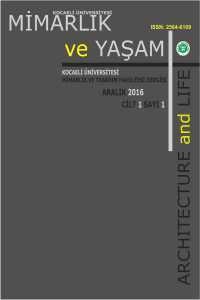Abstract
İstanbul kentsel tarihi 3 bin yıl
öncesine dayanan, Avrupa ile Asya kıtalarının birleştiği noktada bulunan bir şehirdir.
Şehir çağlar boyunca farklı uygarlık ve kültürlere ev sahipliği yapmış,
yüzyıllar boyu çeşitli din, dil ve ırktan insanların bir arada yaşadığı
kozmopolit ve metropolit yapısını korumuş ve tarihsel süreçte eşsiz bir
kültürel mozaik halini almıştır. Tarih boyunca yaşamın her alanında olduğu gibi
özellikle kültür ve sanat konularında da merkez olmuş ve bu merkezde oluşan tüm
gelişmeler dünyayı da etkisi altına almıştır. İstanbul şehri özellikle resim
sanatına da konu olmuş; insanların bu kente olan hayranlıkları ve özlemleri
resim sanatı ile dile getirilmeye çalışılmıştır. Bu durum öncelikle hem Avrupa
resim sanatında hem de Türk resim sanatında daha sonra da iç mekân
dekorasyonlarında yeniliklere yol açmış ve gerek Avrupa’da gerekse de Osmanlı
İmparatorluğu sınırları içerisinde günlük yaşamda değişikliklere neden olmuştur.
Osmanlının Batılılaşma döneminde ortaya çıkan ve İstanbul’u konu alan bu yeni
resim anlayışının ilk görüldüğü yer ise Türk sivil mimarisinin estetik yönünden
zenginleşmesinde önemli yeri bulunan “kalem işi” olarak isimlendirilen duvar
resimleridir. Bu nedenle bu resimlerin incelenmesi ile Osmanlı
İmparatorluğu’nda Batılılaşmanın ortaya çıkışı ve sonuçlarını görmek aynı
zamanda da bu süreçte Avrupa’nın Osmanlı- Türk kültüründen nasıl etkilendiğini
anlamak mümkündür. Günümüze dek bu konuya ilişkin çok az sayıda çalışmanın
yapılmış olması ve resim sanatı ile mimarinin ilgisinin kurularak estetik
yönünün yanında sosyo-kültürel açıdan da konuya yaklaşılması çalışmanın önemini
daha da artırmaktadır.
Keywords
References
- AKIN, N. (2001). Balkanlarda Osmanlı Dönemi Konutları, İstanbul: Literatür Yayıncılık.
- AKŞİT, İ. (2005). The Topkapı Palace, İstanbul: Akşit Yayıncılık.
- ARIK, R.(1975). Anadolu’da Bir Halk Ressamı, Türkiyemiz Dergisi, no.16, s: 9-13.
- ARLI DEMİRSAR B.(2000), Oryantalizmden Çağdaş Türk Resmine, İstanbul:Creative Yayınları.
- BATUR A. (2005). Rural Architecture in the Eastern Black Sea Region, İstanbul: Milli Reasürans Yayınları.
- CEZAR, M. (1995). Sanatta Batı’ya Açılış ve Osman Hamdi, İstanbul: Ekav Vakfı Yayınları.
- ÇALIŞIR, D. (2008). Osmanlı Görsel Kültüründe Meyve Teması: Geleneksel Natürmort Resimleri Bağlamında Bir Değerlendirme, Turkish Studies International Periodical for the Languages, Literature and History of Turkish or Turkic Volume 3/5 Fall 2008, p. 65-86. ISSN: 1308-2140, www.turkishstudies.net, Doi Number: http://dx.doi.org/10.7827/TurkishStudies.410.
Abstract
Istanbul is the city of
which urban history dates to 3000 years back and located in the meeting point
of continents Europe and Asia. Throughout ages, the city has hosted an
abundance of civilizations and cultures, preserved the cosmopolitan and
metropolitan structure that enabled the coexistence of various religions,
languages and races and within historical process, it has turned into a unique
cultural mosaic. During the course of history, just like each and every sphere
of life, it has become a center of culture and art in particular; besides all
the developments emerging in this center have captured the world outside as
well. City of Istanbul has been the topic of painting specifically; the
admiration and longing people nourished for this city have been attempted to
portray through art of painting. This event introduced changes initially in European
painting then Turkish painting and interior space decorations. Additionally,
within European as well as Ottoman Empire borders, it has introduced
alterations in daily life. The first area that the new painting approach having
emerged during Westernizing process of Ottomans and focused on Istanbul is wall
painting that has a noteworthy place in the aesthetical enrichment of Turkish
civilian architecture. For
that reason, by analyzing these paintings, it is possible to view the emergence
and consequences of Westernization in Ottoman Empire and besides understand the
way Europe was affected from Ottoman-Turkish culture during this process. The
fact that so far there has been limited numbers of researches on this topic
elevates the vitality of this study which attempts to establish a connection
between painting and architecture and analyzes its aesthetical as well as
socio-cultural aspect.
Keywords
Interior architecture wall painting Turkish art of painting Orientalism Westernization Istanbul
References
- AKIN, N. (2001). Balkanlarda Osmanlı Dönemi Konutları, İstanbul: Literatür Yayıncılık.
- AKŞİT, İ. (2005). The Topkapı Palace, İstanbul: Akşit Yayıncılık.
- ARIK, R.(1975). Anadolu’da Bir Halk Ressamı, Türkiyemiz Dergisi, no.16, s: 9-13.
- ARLI DEMİRSAR B.(2000), Oryantalizmden Çağdaş Türk Resmine, İstanbul:Creative Yayınları.
- BATUR A. (2005). Rural Architecture in the Eastern Black Sea Region, İstanbul: Milli Reasürans Yayınları.
- CEZAR, M. (1995). Sanatta Batı’ya Açılış ve Osman Hamdi, İstanbul: Ekav Vakfı Yayınları.
- ÇALIŞIR, D. (2008). Osmanlı Görsel Kültüründe Meyve Teması: Geleneksel Natürmort Resimleri Bağlamında Bir Değerlendirme, Turkish Studies International Periodical for the Languages, Literature and History of Turkish or Turkic Volume 3/5 Fall 2008, p. 65-86. ISSN: 1308-2140, www.turkishstudies.net, Doi Number: http://dx.doi.org/10.7827/TurkishStudies.410.
Details
| Primary Language | Turkish |
|---|---|
| Subjects | Architecture |
| Journal Section | Makaleler |
| Authors | |
| Publication Date | December 31, 2016 |
| Published in Issue | Year 2016 Volume: 1 Issue: 1 |
Cited By
SANAT SOSYOLOJİSİ BAĞLAMINDA SON DÖNEM TÜRK RESİM SANATI
İnönü Üniversitesi Kültür ve Sanat Dergisi
https://doi.org/10.22252/ijca.1410836
YAZI - RESİM SÜSLEMESİNE BİR ÖRNEK: AMENTÜ GEMİSİ
Türk Kültürü ve Hacı Bektaş Veli Araştırma Dergisi
https://doi.org/10.60163/hbv.107.008
OSMANLI DEVRİ İSTANBUL TASVİRLERİNDE KIZ KULESİ BETİMLEMELERİ
Motif Akademi Halk Bilimi Dergisi
https://doi.org/10.12981/mahder.1241363
EDİRNE DUMLU KONAĞI DUVAR RESİMLERİ ve SANAT TARİHSEL OKUMALARI
Trakya Üniversitesi Sosyal Bilimler Dergisi
https://doi.org/10.26468/trakyasobed.637912
Osmanlı Resim Sanatında Osman Hamdi Bey, Figür ve Mekan Üzerine Bir Araştırma
JOURNAL OF HISTORY AND FUTURE
https://doi.org/10.21551/jhf.1272116
XVII-XIX. YÜZYILLARDA OSMANLI DÖNEMİ KONUT MİMARİSİ İÇ MEKÂN TASARIMLARINDA TAVAN DEKORLARINA GENEL BİR BAKIŞ
İnsan ve İnsan Dergisi
İlhan Özkeçeci
https://doi.org/10.29224/insanveinsan.398956
17. -20. Yüzyıl Arası Resim Sanatı Örneklerinde İstanbul Tasvirleri Ve Kentsel Bellek
Kocaeli Üniversitesi Mimarlık ve Yaşam Dergisi
Emine Begüm SAVÇIN
https://doi.org/10.26835/my.306324


